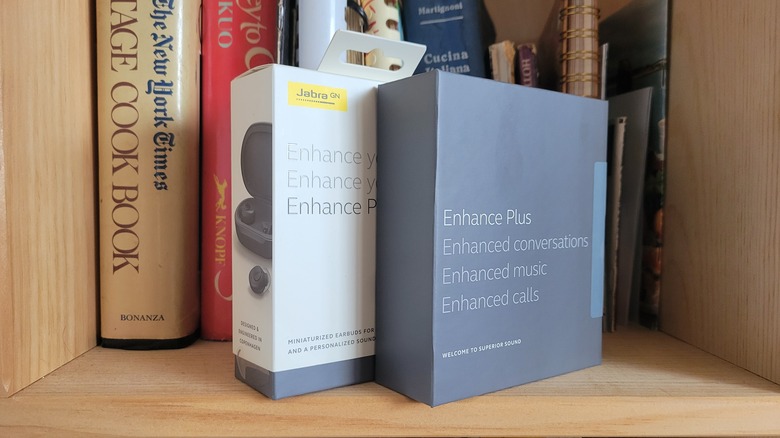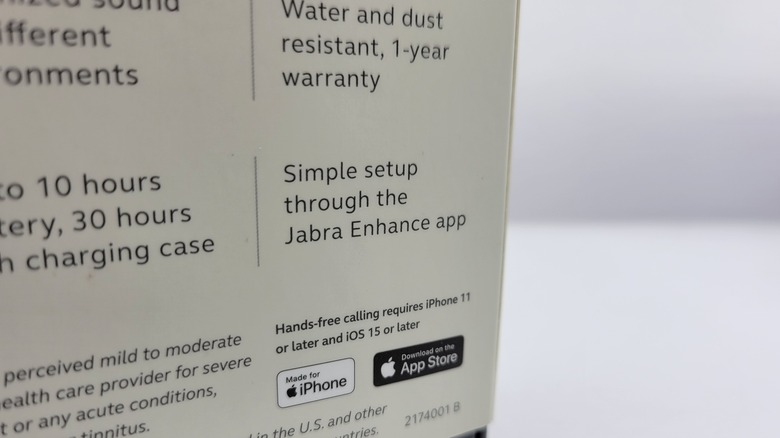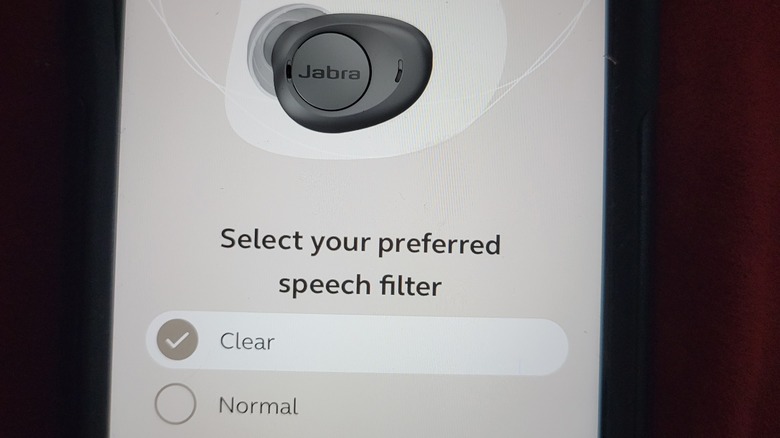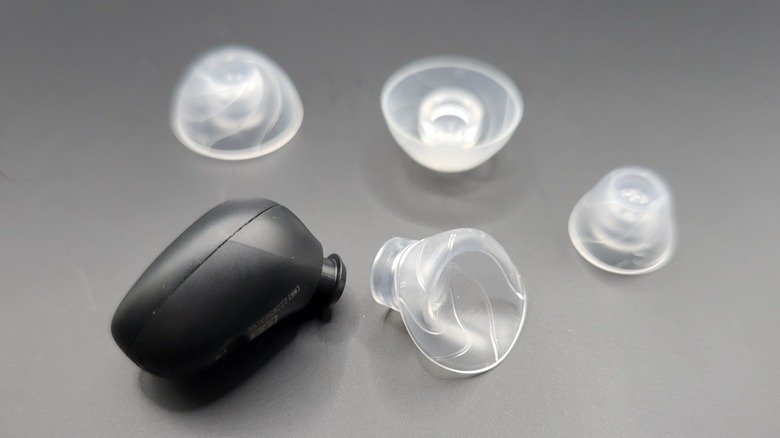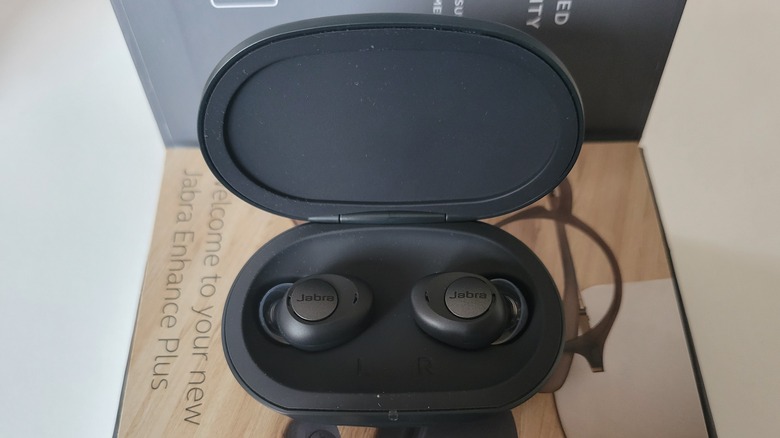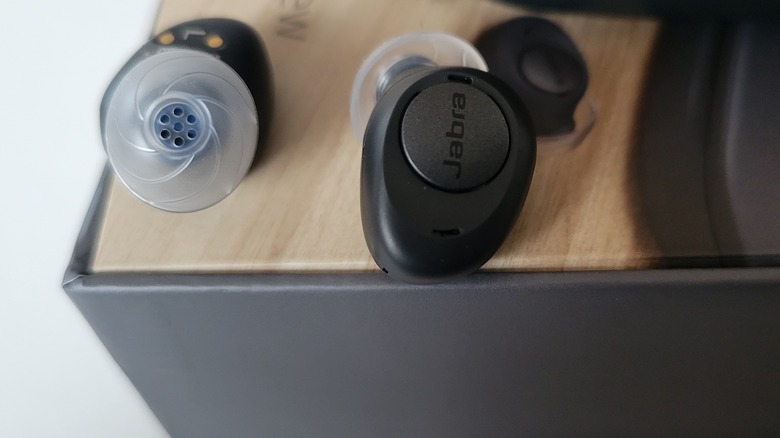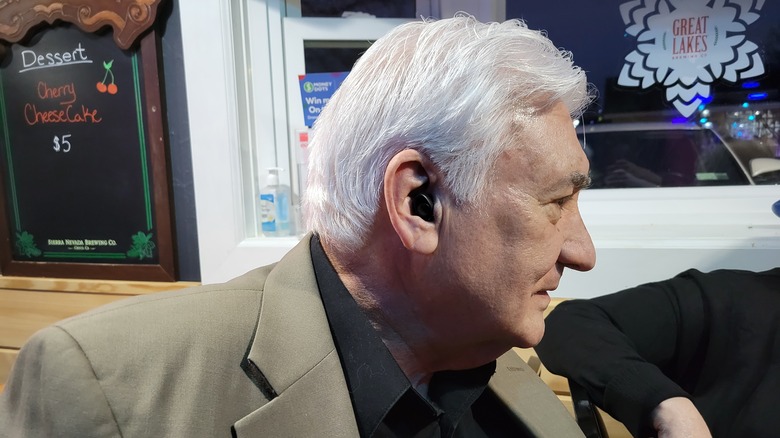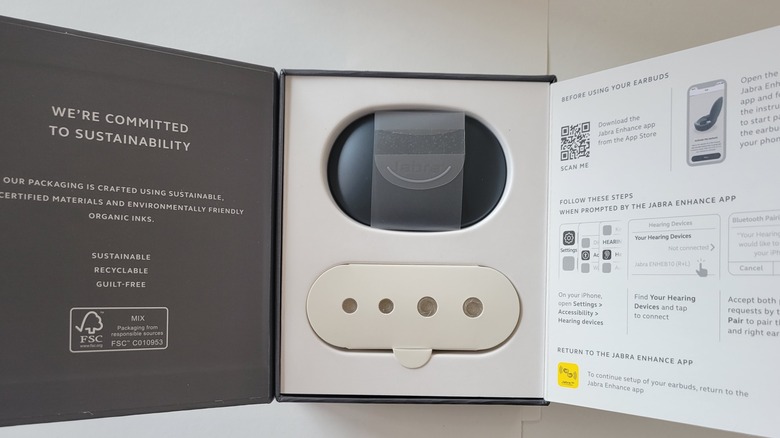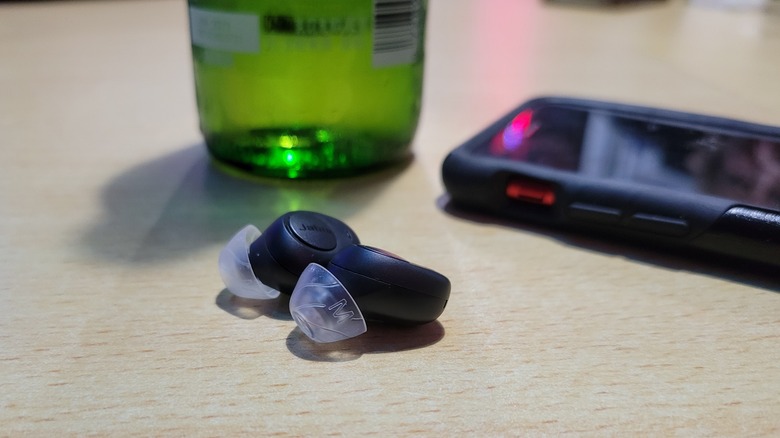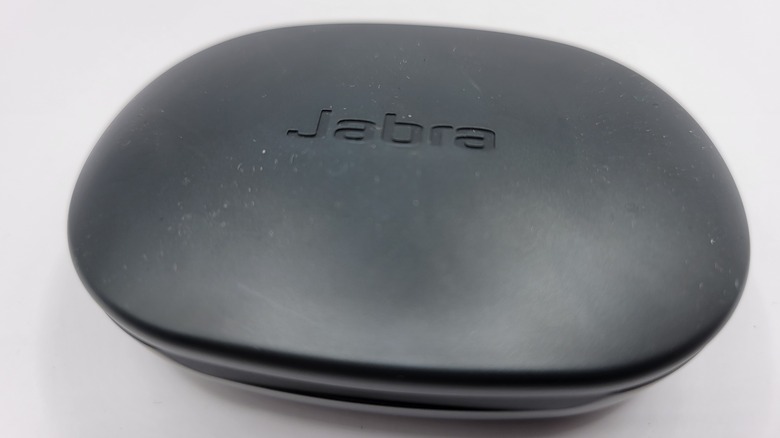Jabra Enhance Plus: Hearing Aids For People Who Don't Want Hearing Aids
Jabra has released the Enhance Plus earbuds — aimed at assisting people who have mild to moderate hearing loss. The earbuds are IP52 rated for water and dust resistance, discrete looking, and at the more accessible end of the hearing aid price range with an MSRP of $799. People wanting to purchase a pair of Jabra's Enhance earbuds must first undergo a hearing assessment with a medical professional. Your health insurance may also cover some, or even all, of the costs involved.
The hearing aids feature digital feedback suppression, background noise suppression, and a "warp compressor" to make their output sound more natural. Along with hearing enhancement, you can use the earbuds to take phone calls and listen to music. The Danish audio brand has also attempted to streamline setup, adjustment, and volume control by pairing the device with its' Jabra Enhance app. Jabra did not design these earbuds for people with no hearing problems, people with more severe hearing loss who may need all-day hearing aids, or hearing aids more directly tailored to their requirements. Jabra has a hearing test on their website for people who suspect they may need some help with their hearing, but this test is not a substitute for the professional medical exam you are required to take before buying the Enhance Plus earbuds.
The earbuds only work with newer iPhones
There is one glaring issue with the Jabra Enhance Plus earbuds. You need a relatively new iPhone if you want them to work at all. There isn't a simple or complex way around this; you either have a device capable of running iOS 14 or later, or you can't use these at any level. If you want to make and receive phone calls through your earbuds, you'll need a phone capable of running iOS 15. Before acquiring an iPhone 12, I downloaded Jabra's standard Android App and tried directly connecting to a Samsung Galaxy over Bluetooth. Neither of these things worked.
In Jabra's defense, the brand makes the iOS requirements clear on the packaging and its website. We did manage to get the earphones working on an older version of the entry-level iPhone SE, as the phone could handle iOS 14. So if you're in the market for a new phone too, you don't need to get a top-of-the-line model to get these hearing aids going. Despite this and whatever technical reasons Jabra has for doing it, restricting the earbuds to newer iPhones severely limits the number of people who can use them and the number of devices they can interact with.
The app can be a pain
You may be considering Jabra's Enhance Plus earbuds to help with your hearing, but setting up the associated app is like pulling teeth. On the face of it, getting the earbuds set up is relatively straightforward. You remove them from the case, pair them with your phone via the app, agree to some terms, perform a calibration test, and you're good to go. And that's precisely how it should work. But it doesn't. Instead, you'll see the app complain you don't have an internet connection if you're relying on your phone's LTE or 5G connection. Even if you've connected to Wi-Fi, the terms page will hang for a very long time. We restarted the app a couple of times, hoping it would get things moving, and it eventually did.
Things get smoother when you make it through the terms and conditions page. The app will ask you to do a short test that involves tapping the screen when you hear a tone. This test calibrates both earbuds to your requirements. Once calibrated, you select a "mode," which is essentially the level of background reduction you want. All of these settings and the calibration can be changed later if you want to keep it low or off in most settings, then ramp up the speech enhancement in noisy settings.
The app proper is quite easy to navigate, and users can get the hang of it quite quickly. However, the less tech-savvy Enhance Plus users might need someone guiding them through it until it becomes familiar. The center of the app's main screen is dedicated to volume adjustment. At the same time, the menu accessible in the top corner allows you to switch between modes and tweak various personalization settings.
Comfortable and customizable to fit any ear
You can wear the hearing aids all day without any discomfort or irritation. The gel fitting ensures a snug fit inside your ear canal, and you can rotate the small earbud until it is comfortably resting on your outer ear. If you were used to the other quirks that come with hearing aids, like your voice sounding amplified or your teeth clacking together sounding like a hammer smacking an anvil, you probably would forget you were wearing them altogether.
The Jabra Enhance Plus earbuds also come with a selection of interchangeable gel fittings so that users can get a comfortable, secure fit no matter the size. Changing a gel fitting is simple; additional "small" and "large" fittings come packaged with the earbuds and a medium-sized pair comes pre-attached. Replacing a gel fitting involves unfolding and pulling off the old one, then pressing the replacement into place. The app visually demonstrates gel-fitting replacement during setup and on request.
The batteries won't last all-day
Jabra's claims of a 10-hour battery life, which extends to 30 when you use the charging case, seem to be accurate. If the earbuds are completely drained, a full charge in the case will take from two to three hours. Fully charging the case, which connects via a USB Type-C port, will take a little longer. Although the earbuds are comfortable and may feel like you can leave them in all day, some planning may be necessary for heavy use. If you plan out a few half-hour stretches where the earbuds go back in their case, all-day use isn't a problem. Say you're working and you decide to top up the batteries while driving; that might be enough to get you through.
This isn't a problem with certain other hearing aids, where the replaceable batteries can last weeks (via Starkey). If you're the sort of person that expects to keep their hearing aids in from sunrise to sunset, opting for the Enhance Plus may lead to some issues.
We had some issues musically
Jabra frames the ability to listen to music as one of Enhance Plus's key selling points. The Danish company makes standard earbuds, like the Elite 75T, so it's easy to expect the audio quality of their Enhance Plus models to be superb. And for the most part, it is; the majority of songs on Spotify or Youtube sound pretty good when streamed directly through the earbuds. That is until it all goes wrong. Enter 1980s icon Elvis Costello, whose hits "Oliver's Army" and "Good Year for the Roses" sounded fine, but whose track "Pump it Up" caused the Enhance Plus all manner of issues. The harder parts of the song caused the bass to distort quite heavily. This could just be an issue with the unit I tested, but it isn't great from something expertly developed by an audio-centric company.
The reliance on the iPhone also limits the earbuds' potential as listening devices. You may be able to pair a TV or a laptop with your iPhone and then use that to play audio through your Enhance Plus earbuds, but that involves a lot of extra steps and won't work with everything. If direct Bluetooth pairing were possible after initial calibration, the earbuds would be much more versatile.
So, how do they rate as hearing aids?
Despite some worries about the length of time I'd spent standing dangerously close to concert speakers, Jabra's online test came as close to confirming my hearing is fine as anyone who isn't a medical professional will admit. So enter Nick, my 76-year-old father-in-law, whose hearing is decent for a septuagenarian but not anywhere near as sharp as it was in 1982. He's the sort of has mild-to-moderate hearing loss but hates the idea of hearing aids individual Jabra may be trying to entice with the Enhance Plus range. Also on hand to provide advice is his brother Joe who has worn hearing aids for several years.
In a way, this is a perfect scenario. My vibrant, youthful eardrums can give a clear assessment of the audio quality when it comes to music, voice calls, and general conversation in obnoxiously noisy environments. My father-in-law can let us know how it enhances the hearing of someone who may need a little help in everyday situations.
What users will initially experience
As a non-hearing-aid user, I experienced firsthand how hard they are to get used to. You will feel a small amount of pressure when you put them in, similar to being underwater. Your voice will seem a lot louder, every time your teeth touch, it will sound like you've just snapped your jaw shut, and every sneeze sounds like a small explosion. Nick had a similar experience but found it could be mitigated by keeping the volume low in most situations. Joe informed us that this is an issue with all hearing aids, and you get used to it. He can adjust his fancy $6,000 pair's "self-hearing" setting by clenching his teeth. I also found I had to concentrate on what people were saying more for some reason.
Conversations sound incredibly clear. There is no difference between people's speaking voices without and through the earbuds, aside from voices being a touch louder with the earbuds in. It's impossible to tell you are listening to things through a small speaker. The speech filter, which reduces background noise, works incredibly well in noisy environments like bars and restaurants.
The earbuds make a difference with mild to moderate hearing loss
Nick wore the earbuds for several days in a number of environments. Each environment came with a different background noise level. His home is reasonably quiet most of the time, the diner he ate at had other customers' conversations boosting the background noise, and the karaoke night at a local bar was quite loud. He said he was happy with the comfort level, though his left earbud fell out two or three times. Nick also claims the earbuds made it far easier to understand people he describes as "mumblers and whisperers," especially when the focus mode (which has the highest level of background noise filtering) was selected.
From what I observed, the Enhance Plus earbuds seemed to positively impact Nick's hearing. There was a point where we had a conversation close to a speaker while music was playing. He didn't need to ask me to repeat or clarify anything in an environment where you would expect hearing things to be a struggle for anyone. The most obvious difference was illustrated when he took the earbuds out for an hour so we had a point of comparison. I noticed him leaning in towards people a lot when conversing with the earbuds out. He hadn't been doing that with the earbuds in. His karaoke performance didn't seem to be affected either, though he did say the increased awareness of his own voice was a distraction.
Their discreet appearance is a major plus
The main reason Nick has avoided getting hearing aids is because of the potential stigma around wearing them. He doesn't want to appear old. He isn't alone in this. Studies, including one by Dr. Margaret I. Wallhagen, have shown that stigma around hearing loss is common amongst older people. It can put people off pursuing treatment or using hearing aids.
This is where the Jabra Enhance Plus excels; they just look like regular earbuds. If you're walking down the street in them, anyone who notices will think you're using them to listen to music or take calls, not enhance your hearing. Adjustments are also discreet, and users make them using their iPhone and the Jabra Enhance app. The earbuds themselves don't need to be touched to change things like volume or enhancement. While this is unlikely to convince everyone, it may be enough to make some people feel comfortable getting the hearing help they need.
Who would you recommend the Jabra Enhance earbuds to?
The medical requirements mean you can't tell people to go out and buy these particular hearing aids, but if someone is experiencing mild to moderate hearing difficulties and is resistant to getting traditional hearing aids, I would have no problem recommending Jabra's effort to them. They're discrete and make an obvious difference to people's hearing, especially in environments with a lot of background noise. The price is also a major plus point.
However, the need for a relatively recent iPhone and clunky app do hold the earbuds back a bit. Both could put a large number of people off and risk overshadowing the things Jabra's earbuds do very well. Fortunately, most of the issues I found with the hearing aids may be fixable should Jabra want to extend their reach or make life a bit easier for their existing customer base. The bottom line is, if you own an eye phone, have mild to moderate hearing loss, and want to improve your hearing without looking like you're wearing hearing aids — consider getting these.
